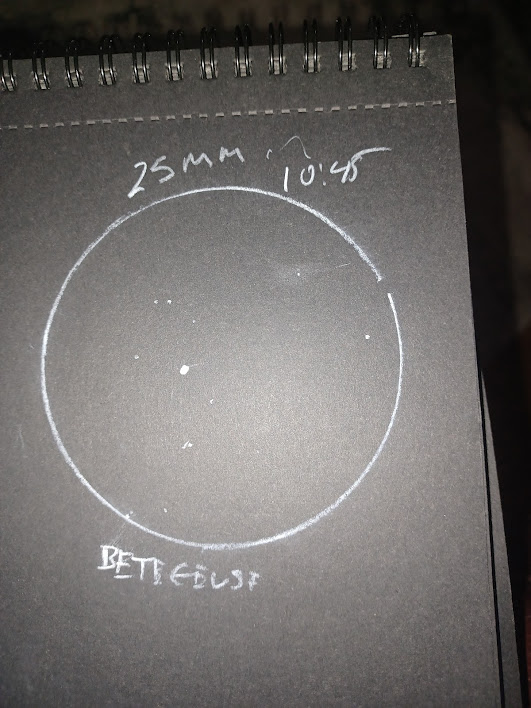Observation Report, 15 March 2024
We finally had a clear night so I could get in at least a little observing. I really wanted to get a chance to use my new sketching tools, I took the pad of black paper, white and grey Prismacolor pencils, and some regular sketching pencils to use in my journal.
I was able to start observing around 21:45MDT. I used the SkyAlign alignment process. For some reason the goto function was consistently off low and left. Using the ed dot finder brought targets into the field of view (FOV).
The Moon was at about 39% full and already pretty bright, high in the west. Transparency I would rate as about a 6 out of 10, and seeing was pretty steady. Since the light from the moon was washing out a lot of stars, and I am still working on my Lunar list, I decided to observe the moon first. I settled on the group of craters Theophilus, Cyrillus, and Catharina. Theophilus is the northernmost, then Cyrillus, then Catharina. I started out with the 25mm eyepiece, then tried 17mm and 13mm, and ended up using the 17mm with a 2x Barlow and the moon filter. This yields a magnification of about 239x.
It's pretty obvious that I need more practice getting the sketches right. They do however serve the purpose of helping me focus and see more detail. The wavy line below Theophilus is a rill or ridge that was catching the sun. There is also a small crater just above the rill. The central peaks in Theophilus and Cyrillus were easily discernible. There is a lot of detail in this area, with many overlapping craters, and some smaller obviously newer craters. For my next Moon session, I think I'll go ahead and try just use the sketching pencils and the white paper in the journal. You can see a photograph here of thee craters, from Sky and Telescope Magazine. From the lighting in the photo, it looks like it was taken at about the same phase of the moon as my observation.
After the moon, I moved on to Betelgeuse. This is one of the variable stars used monitored by the American Association of Variable Star Observers (AAVSO), and is used in their visual measurement training program. Since I have been thinking about that, and it won't be visible in the evening sky for too much longer, I thought I'd take a look. It is a very bright star, that seemed to have just a touch of pink to it in the 25mm eyepiece. It underwent a serious brightening event last June, and is approximately 1.6 times as bright as it was previously.
The last target of the night was a globular cluster in the Eastern sky, Messier 3. I think there was starting to be a thin layer of high altitude ice crystals that wer dimming the view a little. I centered it in the 25mm eyepiece, then switched to the 17mm. I was able to intermittently make out individual stars close to the center and a few more on the periphery.
M3 is about 33,900 l.y. (light years) away. The core is approximately 11 l.y. across, and the entire cluster is about 180 l.y. across. It encompasses about 500,000 stars. Another interesting fact is that it is above the galactic plane, so when we look at it, we are looking opposite our galactic center. Here is a site that has information on it:
https://www.messier-objects.com/messier-3/
I shut down about 23:50, but left the tripod and mount set up with a cover on them. We are supposed to have two or three more clear nights, so I might be able to set up faster if I get to observe.
Some notes on the set up tonight. First, I made a "jacket" out of Reflectix type insulation for both the telescope and the dew shield. I used this brand from Home Depot, and some of the reflective tape they have for that insulation. There is velcro on the overlaps to hold it together and so I can remove it to let everything dry out if necessary. There are a lot of threads on Cloudy Nights discussing how this can help the stabilization of thermal currents in the optical tube and improve seeing. For me the actual importance is helping to keep dew and frost off of the telescope. Last time I was out there was a fair bit of frost on the 'scope and the corrector plate was starting to get some dew/frost by the time I was done. Supposedly these telescopes are built so that they won't be hurt by the frost, but I would prefer not to have that if I can help it. Tonight was a light frost starting when I came in, but the corrector plate was clear. The other things that I did differently were set the tripod feet in the holes in the blocks ( a suggestion from Anne) and hang a gallon of RV anti-freeze from the tripod. The blocks help stabilize the feet and more importantly help keep me from bumping them. The jug acts as a stabilizing weight to decrease any vibration.
This isn't the best picture, but you can see a little of what it looks like.







Comments
Post a Comment